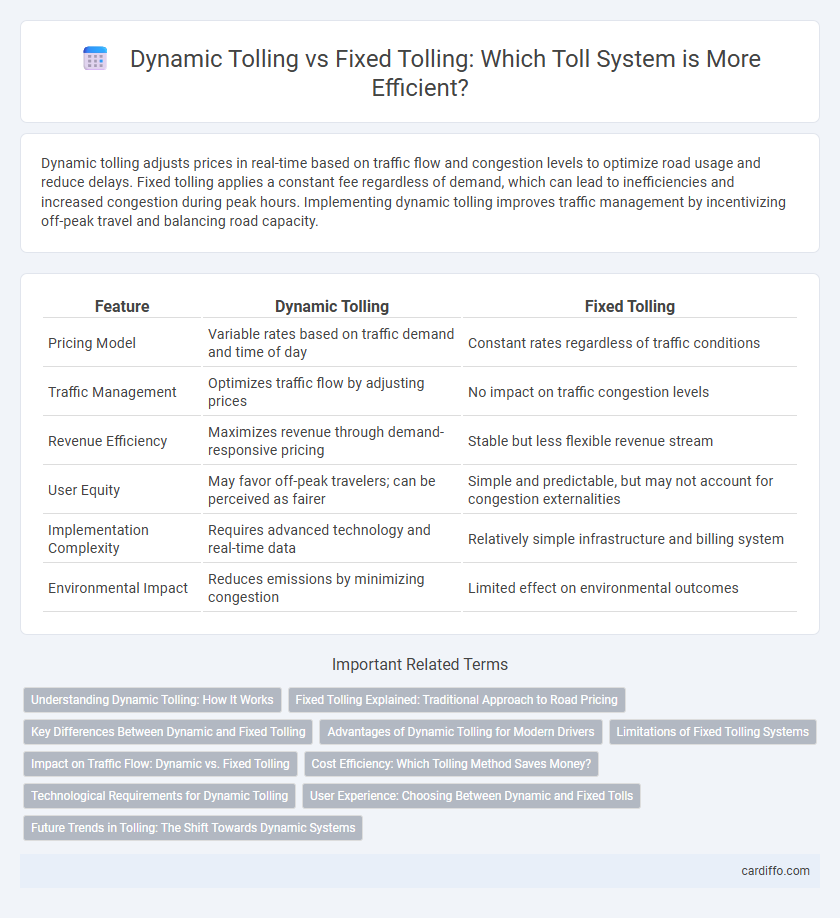Dynamic tolling adjusts prices in real-time based on traffic flow and congestion levels to optimize road usage and reduce delays. Fixed tolling applies a constant fee regardless of demand, which can lead to inefficiencies and increased congestion during peak hours. Implementing dynamic tolling improves traffic management by incentivizing off-peak travel and balancing road capacity.
Table of Comparison
| Feature | Dynamic Tolling | Fixed Tolling |
|---|---|---|
| Pricing Model | Variable rates based on traffic demand and time of day | Constant rates regardless of traffic conditions |
| Traffic Management | Optimizes traffic flow by adjusting prices | No impact on traffic congestion levels |
| Revenue Efficiency | Maximizes revenue through demand-responsive pricing | Stable but less flexible revenue stream |
| User Equity | May favor off-peak travelers; can be perceived as fairer | Simple and predictable, but may not account for congestion externalities |
| Implementation Complexity | Requires advanced technology and real-time data | Relatively simple infrastructure and billing system |
| Environmental Impact | Reduces emissions by minimizing congestion | Limited effect on environmental outcomes |
Understanding Dynamic Tolling: How It Works
Dynamic tolling adjusts road usage fees based on real-time traffic conditions, leveraging data from sensors and GPS systems to manage congestion effectively. Unlike fixed tolling, which charges a constant fee regardless of demand, dynamic tolling uses variable pricing to optimize traffic flow and reduce peak-hour congestion. This system incentivizes drivers to travel during off-peak times, improving overall roadway efficiency and minimizing delays.
Fixed Tolling Explained: Traditional Approach to Road Pricing
Fixed tolling involves predetermined, unchanging toll rates applied consistently regardless of traffic conditions or time of day, providing predictable revenue streams for transportation authorities. This traditional approach simplifies administration and enforcement but may contribute to congestion during peak hours since toll prices do not incentivize off-peak travel. Fixed tolling's straightforward pricing model contrasts with dynamic tolling, which adjusts rates based on real-time traffic data to manage road demand more effectively.
Key Differences Between Dynamic and Fixed Tolling
Dynamic tolling adjusts prices based on real-time traffic conditions, demand, and congestion levels, optimizing roadway usage and reducing traffic jams. Fixed tolling charges a set fee regardless of time or traffic, offering predictability but often leading to inefficiencies during peak hours. The key differences lie in pricing flexibility, congestion management, and overall impact on traffic flow effectiveness.
Advantages of Dynamic Tolling for Modern Drivers
Dynamic tolling adjusts prices based on real-time traffic conditions, reducing congestion and improving travel times for modern drivers. This flexible pricing model encourages off-peak travel, leading to more efficient road usage and lower emissions. By reflecting demand accurately, dynamic tolling offers cost savings and enhanced convenience compared to fixed tolling systems.
Limitations of Fixed Tolling Systems
Fixed tolling systems often struggle with congestion management due to static pricing that fails to reflect real-time traffic conditions. These systems can lead to inefficient road usage, as toll rates do not adjust to peak demand, causing increased delays and pollution. The lack of flexibility in fixed tolling undermines efforts to optimize traffic flow and maximize infrastructure revenue.
Impact on Traffic Flow: Dynamic vs. Fixed Tolling
Dynamic tolling adjusts prices based on real-time traffic conditions, effectively managing congestion by incentivizing off-peak travel and smoothing traffic flow. Fixed tolling charges a constant fee regardless of traffic volume, which can lead to persistent congestion during peak hours. Studies show dynamic tolling reduces traffic delays by up to 30% compared to fixed tolling, enhancing overall roadway efficiency.
Cost Efficiency: Which Tolling Method Saves Money?
Dynamic tolling optimizes cost efficiency by adjusting prices based on real-time traffic conditions, reducing congestion and minimizing delays, which lowers vehicle operating costs and fuel consumption. Fixed tolling, while simpler to administer, may lead to overpricing during off-peak hours and underpricing during peak congestion, resulting in inefficient revenue collection and increased user expenses. Studies show dynamic tolling can increase roadway capacity utilization and generate higher net revenue, ultimately saving money for both operators and drivers.
Technological Requirements for Dynamic Tolling
Dynamic tolling requires advanced technologies such as real-time traffic monitoring systems, GPS-enabled vehicle tracking, and automated payment platforms to adjust toll rates based on congestion levels and traffic flow. Integration of data analytics and machine learning algorithms is essential to predict demand patterns and optimize pricing dynamically. Fixed tolling systems, by contrast, rely on static infrastructure with minimal technological input, focusing primarily on toll collection rather than traffic management.
User Experience: Choosing Between Dynamic and Fixed Tolls
Dynamic tolling enhances user experience by adjusting prices based on real-time traffic conditions, reducing congestion and providing drivers with cost-effective travel options. Fixed tolling offers predictability and simplicity, ensuring consistent toll rates regardless of traffic fluctuations. Users prioritize dynamic tolling for flexibility and efficiency, while fixed tolling appeals for budgeting and straightforward toll management.
Future Trends in Tolling: The Shift Towards Dynamic Systems
Dynamic tolling leverages real-time traffic data and advanced algorithms to adjust prices based on congestion levels, promoting efficient road usage and reducing traffic jams. Future trends indicate a widespread adoption of smart tolling systems integrated with IoT devices and AI to enhance predictive pricing models. These innovations aim to optimize revenue while improving commuter experiences by minimizing delays and supporting sustainable urban mobility.
Dynamic tolling vs fixed tolling Infographic

 cardiffo.com
cardiffo.com